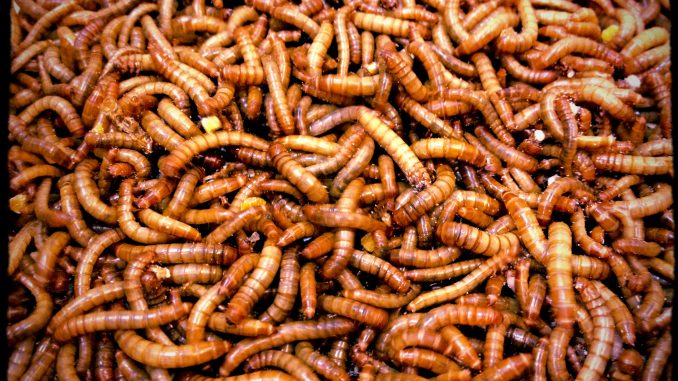
There can be little doubt that food and fake news are two of the most hotly debated topics in the EU. The two even collided violently in recent weeks, following widespread uproar after the EU approved two more insects as safe for human consumption. In response to escalating concerns over climate change and the challenge of feeding the planet’s growing population, the larvae of lesser mealworms and house crickets are set to become the latest addition to Europe’s growing list of edible insects. A further eight applications await approval.
Some anti-EU voices have predictably seized on the approvals as an opportunity to spread misinformation about the initiative. Countless social media posts claim – falsely – that there will be no labelling requirements for food containing insect-based ingredients, while others propagate false connections between consuming insects and a host of diseases.
Caught in the FOP quagmire
The fact of the matter is that the EU clearly doesn’t plan to force insect-based food on the population and that foods containing insects will need to be specifically labelled – even if the shape and form of such a label remains under discussion. In that sense, the unfolding debate about insect-food labelling feeds into, and largely mirrors, that of another, broader one: Europe’s ongoing battle to implement a bloc-wide, politically-neutral food labelling system to facilitate healthy consumer choices.
The fierce debate over front-of-pack (FOP) food labelling has been dynamically led for years but has fundamentally changed in outlook at present, thanks to the high level of politicisation. At the core is the Nutri-score, a France-backed system that assesses the sugar, fat and salt content of products according to a five-point sliding scale ranging from a green At o a red E.
Despite early adoption in western European countries like France, Belgium, Germany and the Netherlands, the Nutri-score system has been widely criticised for marking down foods containing olive oil, cheese and cured meats due to their fat content. In practice, this means that Nutri-score disproportionately discriminates against traditional and relatively unprocessed foods in spite of their well-documented health benefits.
That the Nutri-score algorithm fails to take into account the positive benefits of eating certain fats and proteins in moderation has been met with staunch opposition in Europe’s south. Last year, the Italian Competition Authority (AGCM) called on major supermarkets to withdraw the labelling from Italian shelves, and the Safe Food Advocacy Europe (SAFE) slammed the algorithm for misleading consumers. In the end, the scientists behind the system had to adapt the algorithm in an implicit admission of Nutri-Score’s failings.
Nutri-Score won’t be it
Even so, it’s clear that the Nutri-Score irrecoverably lost lots of goodwill among European policy circles. In a surprising move, the EU Commission clarified in October last year that the final FOP label will not, in fact, be Nutri-Score. Not only was this a fundamental shift in tone, but the move has also torn the debate wide open once more. Late last year, a European Parliament roundtable debate examined a number of alternatives currently in use across Europe. Among others, the Nordic Keyhole nutritional label and Italy’s Nutrinform are major contenders for forming an informed basis of what a harmonised Europe-wide labelling scheme could like.
The Nordic Keyhole nutrition label has been implemented in Sweden, Denmark, Norway and Lithuania, as well as European economic area countries Norway and Iceland. So far, it is offered as a voluntary label that differentiates between products within different product groups based on dietary fibre, wholegrains, saturated fat, salt and sugar.
The Keyhole has been designed as a positive symbol. Instead of telling consumers what not to eat, it purports to help them make healthier choices within product groups. More than 4,000 products currently carry the Keyhole symbol, and its credibility is encouragingly high among consumers.
Meanwhile, the NutrInform Battery was recently made the official system in Italy, conceived by a working group made up of experts from Italy’s Health, Agriculture, Foreign Affairs and Economic Development ministries. The label is designed to emphasise nutritional knowledge about products, and encourage more informed choices by consumers.
“With the proposal of the Italian system of nutritional labelling, NutrInform, Italy intends to look to the future of European agri-food systems, since our country cannot accept the trend towards a model of homologation of agri-food product,” said Italy’s Minister of Agricultural, Food and Forestry Policies Stefano Patuanelli of the system.
No end in sight
While the EU Commission made it clear that it likely won’t be adopting any already existing labels, they nonetheless are considered to serve as an inspiration for an alternative model that could combine the best of both. Yet no matter which FOP the Commission eventually chooses, the bigger debate about food and healthy dietary choices in Europe is sure to rage on.
To what extent insects will become a staple food in Europe in the years to come remains to be seen and the EU’s approval is certainly going to remain a source of much controversy at a time when proponents argue for the health and sustainability advantages of insects as climate change accelerates – even if the “disgust” factor undoubtedly remains a hurdle for popular uptake.
Such debates could compound the perpetually smouldering FOP debate by introducing the issue of not only having create a label that appropriately informs consumers of food’s nutritional value, but also, increasingly, of its exact ingredients. Given that the EU has already spent years on Nutri-Score, including postponing the date for a definitive decision, it seems there’s a real risk of the Commission doing two steps ahead and one step back. Indeed, once all is said and done, the EU risks not having made any progress on such fundamental questions at all.
Image: Len Urratia/Flickr


Leave a Reply